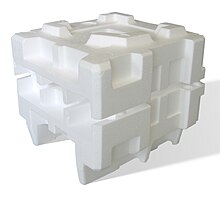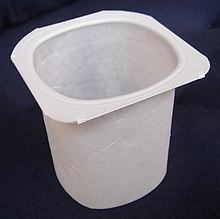Polistiréna: Béda antarrépisi
Tidak ada ringkasan suntingan |
m Ngarapihkeun éjahan, replaced: oge → ogé , geusan → pikeun , make → maké , dipake → dipaké (3), diantara → di antara, ea → éa, eo → éo, didieu → di dieu, naluntik → nalungtik, kalolobaan → lolobana |
||
| Baris ka-1: | Baris ka-1: | ||
[[File:Polystyrene.svg|thumb|180px|Bagiean kantétan polistirene.]] |
[[File:Polystyrene.svg|thumb|180px|Bagiean kantétan polistirene.]] |
||
[[File:Expanded polystyrene foam dunnage.jpg|thumb|Pamungkus tina polistyréné (Expanded)/EPS |
[[File:Expanded polystyrene foam dunnage.jpg|thumb|Pamungkus tina polistyréné (Expanded)/EPS]] |
||
[[File:Envase de yogur.jpg|thumb| |
[[File:Envase de yogur.jpg|thumb|Wadah yogurt tina bahan polistyréné]] |
||
[[File:Polystyrol-IR.png|thumb|right|160px|Spéktrum transmisi Infrabeureum film polystyrene.]] |
[[File:Polystyrol-IR.png|thumb|right|160px|Spéktrum transmisi Infrabeureum film polystyrene.]] |
||
'''Polystyrene''' ('''PS''')/IPAc-en|ˌ|p|ɒ|l|i|ˈ|s|t|aɪ|r|iː|n /Polistiréné (PS) mangrupa polimér aromatik sintétik anu dijieun tina ''styrene monomer''. Polistiréné wujudna bisa waé padet atawa busa-na. Sipat umum polistiréné geus jelas saperti teuas, sarta rada regas. Harga tiap kilona kawilang murah. |
'''Polystyrene''' ('''PS''')/IPAc-en|ˌ|p|ɒ|l|i|ˈ|s|t|aɪ|r|iː|n /Polistiréné (PS) mangrupa polimér aromatik sintétik anu dijieun tina ''styrene monomer''. Polistiréné wujudna bisa waé padet atawa busa-na. Sipat umum polistiréné geus jelas saperti teuas, sarta rada regas. Harga tiap kilona kawilang murah.<ref name="acc">{{cite web|title=Common Plastic Resins Used in Packaging|url=http://plastics.americanchemistry.com/Education-Resources/Hands-on-Plastics/Introduction-to-Plastics-Science-Teaching-Resources/History-of-Polymers-Plastics-for-Teachers.html|work=Introduction to Plastics Science Teaching Resources|publisher=American Chemistry Council, Inc.|accessdate=24 December 2012}}</ref> Polistiréné téh aslinamah bisa hérang/transparan, tapi bisa waé maké kelir éta gumantung kabutuhan. Sok dipaké ogé pamungkus luar (seperti mungkus [[kacang]], CD, DVD jeung lain-laina), wadah (saperti "clamshell"), tutup, [[botol]], [[gelas]], jeung [[séndok]], [[garpu]] sakali paké. |
||
<ref>[http://plastics.ulprospector.com/generics/43/polystyrene-ps ulpospector]</ref> |
<ref>[http://plastics.ulprospector.com/generics/43/polystyrene-ps ulpospector]</ref> |
||
Hanjakalna polistiréné ieu lila pisan ancurna henteu ''biodegrade'' anu matak jadi bahan anu terus disawalakeun, pangpangna lamun ieu barang seug mah dipiceun samarangan ka susukan atawa got ieu plastik tangtuna bakal ngajadikeun hiji sabab banjir. Lantaran bisa mengpetan liang [[cai]]. |
Hanjakalna polistiréné ieu lila pisan ancurna henteu ''biodegrade'' anu matak jadi bahan anu terus disawalakeun, pangpangna lamun ieu barang seug mah dipiceun samarangan ka susukan atawa got ieu plastik tangtuna bakal ngajadikeun hiji sabab banjir. Lantaran bisa mengpetan liang [[cai]]. |
||
| Baris ka-10: | Baris ka-10: | ||
==Sajarah== |
==Sajarah== |
||
Polystyrene/polistiréné kapanggih ku [[Eduard Simon]] dina taun [[1839]],<ref>[http://inventors.about.com/od/pstartinventions/a/plastics.htm The history of plastics]. Inventors.about.com (15 June 2010). Retrieved 25 December 2011.</ref> saurang apotékér ti [[Bérlin]]. Di storax ti [[Turki]], manéhna nyuling/ ''distilled résin'' anu asalna tina geutah tangkal sweetgum orientalis anu ngandung minyak, anu hasilna dibéré ngaran styrol. Sababaraha poé tiharita ieu Simon manggihan yén styrol jadi jelly/ngageblég ku alatan aya oksida ("Styroloxyd"). Saterusna kimiawan [[John Buddle Blyth]] anu lahir [[1845]] jeung ahli [[kimia]] urang [[Jérman]] [[Agustus Wilhelm von Hofmann]] némbongkeun yén salila ''transformation'' styrol lumangsung henteu ngabutuhkeun oksigén. Maranéhanana nyebut ieu zat métastyrol. Panalungtikan satuluyna ngébréhkeun yén ieu kimia téh sarua pisan/idéntik jeung [[Styroloxyd]]. Dina taun [[1866]] Marcelin Berthelot |
Polystyrene/polistiréné kapanggih ku [[Eduard Simon]] dina taun [[1839]],<ref>[http://inventors.about.com/od/pstartinventions/a/plastics.htm The history of plastics]. Inventors.about.com (15 June 2010). Retrieved 25 December 2011.</ref> saurang apotékér ti [[Bérlin]]. Di storax ti [[Turki]], manéhna nyuling/ ''distilled résin'' anu asalna tina geutah tangkal sweetgum orientalis anu ngandung minyak, anu hasilna dibéré ngaran styrol. Sababaraha poé tiharita ieu Simon manggihan yén styrol jadi jelly/ngageblég ku alatan aya oksida ("Styroloxyd"). Saterusna kimiawan [[John Buddle Blyth]] anu lahir [[1845]] jeung ahli [[kimia]] urang [[Jérman]] [[Agustus Wilhelm von Hofmann]] némbongkeun yén salila ''transformation'' styrol lumangsung henteu ngabutuhkeun oksigén. Maranéhanana nyebut ieu zat métastyrol. Panalungtikan satuluyna ngébréhkeun yén ieu kimia téh sarua pisan/idéntik jeung [[Styroloxyd]]. Dina taun [[1866]] Marcelin Berthelot nalungtik ieu formasi metastyrol / Styroloxyd ti styrol salaku prosés polimérisasi. Saengeusna 80 kaliwat kakara kapanggih yén manaskeun styrol bakalngahasilkeun réaksi kantétan makromolekul, manehna ahli kimia organik Jerman Hermann Staudinger ([[1881]]-[[1965]]) nya dingaranan waé ieu zat téh nyaéta ''polystyrene''. |
||
Pausahaan IG Farben mimiti muka pabrik polystyrene di Ludwigshafen, dina taun [[1931]], ieu bakal jadi gaganti [[séng]] dina loba kagunaan. Sukses ieu kahontal nalika tumuwuh wadah réaktor |
Pausahaan IG Farben mimiti muka pabrik polystyrene di Ludwigshafen, dina taun [[1931]], ieu bakal jadi gaganti [[séng]] dina loba kagunaan. Sukses ieu kahontal nalika tumuwuh wadah réaktor pikeun nga extruded polystyrene ngaliwatan tabung/solobong/tube dipanaskeun tuliy dipotongan, ngahasilkeun polystyrene dina bentuk pellet/guruntulan. |
||
Dina taun [[1941]], Dow Chemical nyiptakeun proses Styrofoam. |
Dina taun [[1941]], Dow Chemical nyiptakeun proses Styrofoam.<ref>{{cite web|title=Invention of STYROFOAM™|url=http://building.dow.com/about/invention.htm|publisher=Dow Chemical|accessdate=23 December 2012}}</ref> |
||
Saméméh taun [[1949]], insinyur kimia saengang Stastny ([[1908]]-[[1985]]) dimekarkeun pre-dilegaan manik PS ku incorporating hidrokarbon alifatik, saperti pentane. Di handap ieu mangrupa bahan baku pikeun molding bagian atawa extruding. BASF jeung Stastny diterapkeun keur patén nu dikaluarkeun dina 1949. Prosés molding ieu nunjukkeun di Kunststoff Messe [[1952]] di Düsseldorf. Produk anu ngaranna Styropor. |
Saméméh taun [[1949]], insinyur kimia saengang Stastny ([[1908]]-[[1985]]) dimekarkeun pre-dilegaan manik PS ku incorporating hidrokarbon alifatik, saperti pentane. Di handap ieu mangrupa bahan baku pikeun molding bagian atawa extruding. BASF jeung Stastny diterapkeun keur patén nu dikaluarkeun dina 1949. Prosés molding ieu nunjukkeun di Kunststoff Messe [[1952]] di Düsseldorf. Produk anu ngaranna Styropor. |
||
| Baris ka-22: | Baris ka-22: | ||
Dina taun [[1954]], Koppers Company di [[Pittsburgh]], [[Pennsylvania]], mekarkeun (EPS)/busa kalayan ngaran dagang Dylite.<ref>Page 207 of Rigid Plastics Foams 2nd edition by T.H. Ferrigno published in 1967.</ref> |
Dina taun [[1954]], Koppers Company di [[Pittsburgh]], [[Pennsylvania]], mekarkeun (EPS)/busa kalayan ngaran dagang Dylite.<ref>Page 207 of Rigid Plastics Foams 2nd edition by T.H. Ferrigno published in 1967.</ref> |
||
Dina taun [[1960]], [[Dart Container]], mangrupa pabrik cangkir tina bahan busa pangbadagna, order kahiji maranéhanana. |
Dina taun [[1960]], [[Dart Container]], mangrupa pabrik cangkir tina bahan busa pangbadagna, order kahiji maranéhanana.<ref>{{cite web|title=Celebrating 50 Years of Excellence in People and Products|url=http://www.dartcontainer.com/web/products.nsf/pages/celebrating50timeline.html|publisher=Dart Container Corporation|accessdate=23 December 2012}}</ref> |
||
Taun [[1988]], AS mimiti ngabatesan ieu |
Taun [[1988]], AS mimiti ngabatesan ieu pamakéan busa polystyrene keur dipaké umum di [[Berkeley]], [[California]].<ref name="berkeley-1988">{{cite news|title=Berkeley Widens Ban on Foam Food Containers|url=http://articles.latimes.com/1988-06-16/news/mn-6881_1_foam-food-containers|accessdate=23 December 2012|newspaper=The Los Angeles Times|date=16 June 1988}}</ref> |
||
==Golongan Polistirene== |
==Golongan Polistirene== |
||
Dumasar kana sipat pisik jeung paninggalian, ieu bahan polistirene dibedakeun kana opat golongan |
Dumasar kana sipat pisik jeung paninggalian, ieu bahan polistirene dibedakeun kana opat golongan di antarana wae: |
||
#GPPS PS (Basa Inggris: ''General Purpose Polystyrene''), katempona herang/ transparan, teuas, sarta regas. |
#GPPS PS (Basa Inggris: ''General Purpose Polystyrene''), katempona herang/ transparan, teuas, sarta regas. |
||
#HIPS (Basa Inggris: ''High impact Polystyrene''), rada kuat henteu regas jiga GPPS warnana bodas susu (White opaque) |
#HIPS (Basa Inggris: ''High impact Polystyrene''), rada kuat henteu regas jiga GPPS warnana bodas susu (White opaque) |
||
| Baris ka-33: | Baris ka-33: | ||
==Barang anu dihasilkeun== |
==Barang anu dihasilkeun== |
||
Polystyrene/polistirene |
Polystyrene/polistirene lolobanaa dipaké dina mesin citakan /[[injection molding]], sistem sedot [[vacuum forming]], atawa di [[extruded]], expandedPolystyrene/polistirene dijieun maké citakan husus . Polystyrene/polistirene kopolimer ogé bisa dijieun; di dieu bahan ieu ngandung hiji ata leuwih monomers dicampurkeun kana [[stirene]].<ref>{{cite journal|author=Doroudiani S, Kortschot MT|year=2004|title=Expanded Wood Fiber Polystyrene Composites: Processing-Structure-Mechanical Properties Relationships|journal=Journal of Thermoplastic Composite Materials|volume=17|pages=13–30|doi=10.1177/0892705704035405}}</ref><ref>{{cite journal|doi=10.1002/polb.10129|title=Sorption and diffusion of carbon dioxide in wood-fiber/polystyrene composites|year=2002|last1=Doroudiani|first1=Saeed|last2=Chaffey|first2=Charles E.|last3=Kortschot|first3=Mark T.|journal=Journal of Polymer Science Part B: Polymer Physics|volume=40|page=723|issue=8}}</ref> and starch<ref>{{cite journal|doi=10.1177/0021955X07076532|title=Foaming of Polystyrene/ Thermoplastic Starch Blends|year=2007|last1=Mihai|first1=M.|last2=Huneault|first2=M. A.|last3=Favis|first3=B. D.|journal=Journal of Cellular Plastics|volume=43|page=215|issue=3}}</ref> |
||
==Tingali oge== |
==Tingali oge== |
||
| Baris ka-39: | Baris ka-39: | ||
*[[Polycarbonate]] |
*[[Polycarbonate]] |
||
*[[Poliétilén]] |
*[[Poliétilén]] |
||
*[[Poliétilén terephtalate]] (Katelah disebut PET biasana |
*[[Poliétilén terephtalate]] (Katelah disebut PET biasana dipaké [[botol]], ogé [[polyester]] dipaké bahan [[baju]] |
||
*[[Polipropiléné]] |
*[[Polipropiléné]] |
||
* |
*Polistiréna |
||
*[[Polyurethane]] |
*[[Polyurethane]] |
||
*[[Polyvinyl chloride]] (Katelahna PVC). biasana dipaké [[bungkus]] [[kabel]] [[listrik]]. |
*[[Polyvinyl chloride]] (Katelahna PVC). biasana dipaké [[bungkus]] [[kabel]] [[listrik]]. |
||
==Tutumbu kaluar== |
==Tutumbu kaluar== |
||
* |
*[http://www.plasticseurope.org/what-is-plastic/types-of-plastics-11148/expanded-polystyrene.aspx Platicseurope] |
||
* |
*[http://plastics.ulprospector.com/generics/43/polystyrene-ps ulpospector] |
||
* [http://riodb01.ibase.aist.go.jp/sdbs/cgi-bin/cre_index.cgi?lang=eng Infrarot und Ramanspektrum von Polystyrol] |
* [http://riodb01.ibase.aist.go.jp/sdbs/cgi-bin/cre_index.cgi?lang=eng Infrarot und Ramanspektrum von Polystyrol] |
||
* [http://www.waermedaemmstoffe.com/htm/polystyrol.htm www.waermedaemmstoffe.com] technische Informationen zu den Dämmstoffen Styropor (EPS) und Styropor (XPS) |
* [http://www.waermedaemmstoffe.com/htm/polystyrol.htm www.waermedaemmstoffe.com] technische Informationen zu den Dämmstoffen Styropor (EPS) und Styropor (XPS) |
||
* [http://www.materialarchiv.ch/#/detail/41/expandiertes-polystyrol/ MATERIAL ARCHIV: Expandiertes Polystyrol] – Umfangreiche Materialinformationen und Bilder |
* [http://www.materialarchiv.ch/#/detail/41/expandiertes-polystyrol/ MATERIAL ARCHIV: Expandiertes Polystyrol] – Umfangreiche Materialinformationen und Bilder |
||
* [http://www.youtube.com/watch?v=uJ6-jRo1izY Spannungsrisskorrosion von PMMA und PS] Youtube |
* [http://www.youtube.com/watch?v=uJ6-jRo1izY Spannungsrisskorrosion von PMMA und PS] Youtube Vidéo: Crazes bei PS |
||
{{pondok}} |
{{pondok}} |
||
Révisi nurutkeun 27 Januari 2017 07.11




Polystyrene (PS)/IPAc-en|ˌ|p|ɒ|l|i|ˈ|s|t|aɪ|r|iː|n /Polistiréné (PS) mangrupa polimér aromatik sintétik anu dijieun tina styrene monomer. Polistiréné wujudna bisa waé padet atawa busa-na. Sipat umum polistiréné geus jelas saperti teuas, sarta rada regas. Harga tiap kilona kawilang murah.[1] Polistiréné téh aslinamah bisa hérang/transparan, tapi bisa waé maké kelir éta gumantung kabutuhan. Sok dipaké ogé pamungkus luar (seperti mungkus kacang, CD, DVD jeung lain-laina), wadah (saperti "clamshell"), tutup, botol, gelas, jeung séndok, garpu sakali paké. [2] Hanjakalna polistiréné ieu lila pisan ancurna henteu biodegrade anu matak jadi bahan anu terus disawalakeun, pangpangna lamun ieu barang seug mah dipiceun samarangan ka susukan atawa got ieu plastik tangtuna bakal ngajadikeun hiji sabab banjir. Lantaran bisa mengpetan liang cai.
Sajarah
Polystyrene/polistiréné kapanggih ku Eduard Simon dina taun 1839,[3] saurang apotékér ti Bérlin. Di storax ti Turki, manéhna nyuling/ distilled résin anu asalna tina geutah tangkal sweetgum orientalis anu ngandung minyak, anu hasilna dibéré ngaran styrol. Sababaraha poé tiharita ieu Simon manggihan yén styrol jadi jelly/ngageblég ku alatan aya oksida ("Styroloxyd"). Saterusna kimiawan John Buddle Blyth anu lahir 1845 jeung ahli kimia urang Jérman Agustus Wilhelm von Hofmann némbongkeun yén salila transformation styrol lumangsung henteu ngabutuhkeun oksigén. Maranéhanana nyebut ieu zat métastyrol. Panalungtikan satuluyna ngébréhkeun yén ieu kimia téh sarua pisan/idéntik jeung Styroloxyd. Dina taun 1866 Marcelin Berthelot nalungtik ieu formasi metastyrol / Styroloxyd ti styrol salaku prosés polimérisasi. Saengeusna 80 kaliwat kakara kapanggih yén manaskeun styrol bakalngahasilkeun réaksi kantétan makromolekul, manehna ahli kimia organik Jerman Hermann Staudinger (1881-1965) nya dingaranan waé ieu zat téh nyaéta polystyrene.
Pausahaan IG Farben mimiti muka pabrik polystyrene di Ludwigshafen, dina taun 1931, ieu bakal jadi gaganti séng dina loba kagunaan. Sukses ieu kahontal nalika tumuwuh wadah réaktor pikeun nga extruded polystyrene ngaliwatan tabung/solobong/tube dipanaskeun tuliy dipotongan, ngahasilkeun polystyrene dina bentuk pellet/guruntulan.
Dina taun 1941, Dow Chemical nyiptakeun proses Styrofoam.[4]
Saméméh taun 1949, insinyur kimia saengang Stastny (1908-1985) dimekarkeun pre-dilegaan manik PS ku incorporating hidrokarbon alifatik, saperti pentane. Di handap ieu mangrupa bahan baku pikeun molding bagian atawa extruding. BASF jeung Stastny diterapkeun keur patén nu dikaluarkeun dina 1949. Prosés molding ieu nunjukkeun di Kunststoff Messe 1952 di Düsseldorf. Produk anu ngaranna Styropor.
Struktur kristal tina polystyrene isotactic ieu dilaporkeun ku Giulio Natta.[5]
Dina taun 1954, Koppers Company di Pittsburgh, Pennsylvania, mekarkeun (EPS)/busa kalayan ngaran dagang Dylite.[6]
Dina taun 1960, Dart Container, mangrupa pabrik cangkir tina bahan busa pangbadagna, order kahiji maranéhanana.[7]
Taun 1988, AS mimiti ngabatesan ieu pamakéan busa polystyrene keur dipaké umum di Berkeley, California.[8]
Golongan Polistirene
Dumasar kana sipat pisik jeung paninggalian, ieu bahan polistirene dibedakeun kana opat golongan di antarana wae:
- GPPS PS (Basa Inggris: General Purpose Polystyrene), katempona herang/ transparan, teuas, sarta regas.
- HIPS (Basa Inggris: High impact Polystyrene), rada kuat henteu regas jiga GPPS warnana bodas susu (White opaque)
- EPS (Basa Inggris: Polystyrene Expandable; PSE di Prancis) EPS nyaéta busa padet kalayan kombinasi unik karakteristik, kawas herang, sipat panutup/insulasi, kakuatan keur nahan. EPS dipaké dina loba aplikasi kawas papan insulasi termal di gedong, bungkusan, paragi nyimpen barang berharga jeung bungkusan dahareun.[9]
Barang anu dihasilkeun
Polystyrene/polistirene lolobanaa dipaké dina mesin citakan /injection molding, sistem sedot vacuum forming, atawa di extruded, expandedPolystyrene/polistirene dijieun maké citakan husus . Polystyrene/polistirene kopolimer ogé bisa dijieun; di dieu bahan ieu ngandung hiji ata leuwih monomers dicampurkeun kana stirene.[10][11] and starch[12]
Tingali oge
- Polyamide (Disebut ogé nylon)
- Polycarbonate
- Poliétilén
- Poliétilén terephtalate (Katelah disebut PET biasana dipaké botol, ogé polyester dipaké bahan baju
- Polipropiléné
- Polistiréna
- Polyurethane
- Polyvinyl chloride (Katelahna PVC). biasana dipaké bungkus kabel listrik.
Tutumbu kaluar
- Platicseurope
- ulpospector
- Infrarot und Ramanspektrum von Polystyrol
- www.waermedaemmstoffe.com technische Informationen zu den Dämmstoffen Styropor (EPS) und Styropor (XPS)
- MATERIAL ARCHIV: Expandiertes Polystyrol – Umfangreiche Materialinformationen und Bilder
- Spannungsrisskorrosion von PMMA und PS Youtube Vidéo: Crazes bei PS
| Artikel ieu mangrupa taratas, perlu disampurnakeun. Upami sadérék uninga langkung paos perkawis ieu, dihaturan kanggo ngalengkepan. |
Rujukan
- ↑ "Common Plastic Resins Used in Packaging". Introduction to Plastics Science Teaching Resources. American Chemistry Council, Inc. Diakses tanggal 24 December 2012.
- ↑ ulpospector
- ↑ The history of plastics. Inventors.about.com (15 June 2010). Retrieved 25 December 2011.
- ↑ "Invention of STYROFOAM™". Dow Chemical. Diakses tanggal 23 December 2012.
- ↑ doi:10.1007/BF02731861
This citation will be automatically completed in the next few minutes. You can jump the queue or expand by hand - ↑ Page 207 of Rigid Plastics Foams 2nd edition by T.H. Ferrigno published in 1967.
- ↑ "Celebrating 50 Years of Excellence in People and Products". Dart Container Corporation. Diakses tanggal 23 December 2012.
- ↑ "Berkeley Widens Ban on Foam Food Containers". The Los Angeles Times. Citakan:ISO date/en. http://articles.latimes.com/1988-06-16/news/mn-6881_1_foam-food-containers. Diakses pada 23 December 2012
- ↑ plasticeurope
- ↑ Doroudiani S, Kortschot MT (2004). "Expanded Wood Fiber Polystyrene Composites: Processing-Structure-Mechanical Properties Relationships". Journal of Thermoplastic Composite Materials 17: 13–30. doi:10.1177/0892705704035405.
- ↑ Doroudiani, Saeed; Chaffey, Charles E.; Kortschot, Mark T. (2002). "Sorption and diffusion of carbon dioxide in wood-fiber/polystyrene composites". Journal of Polymer Science Part B: Polymer Physics 40 (8): 723. doi:10.1002/polb.10129.
- ↑ Mihai, M.; Huneault, M. A.; Favis, B. D. (2007). "Foaming of Polystyrene/ Thermoplastic Starch Blends". Journal of Cellular Plastics 43 (3): 215. doi:10.1177/0021955X07076532.

